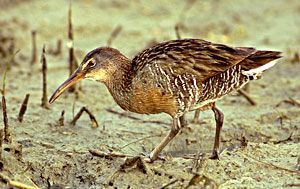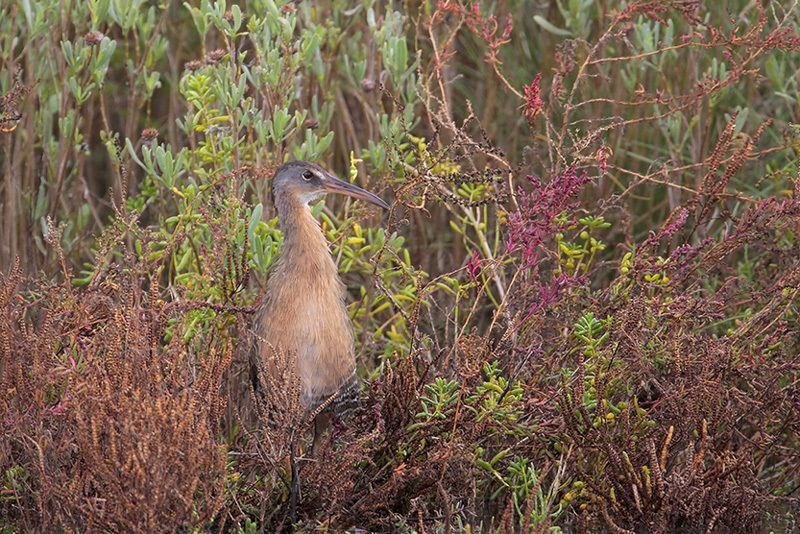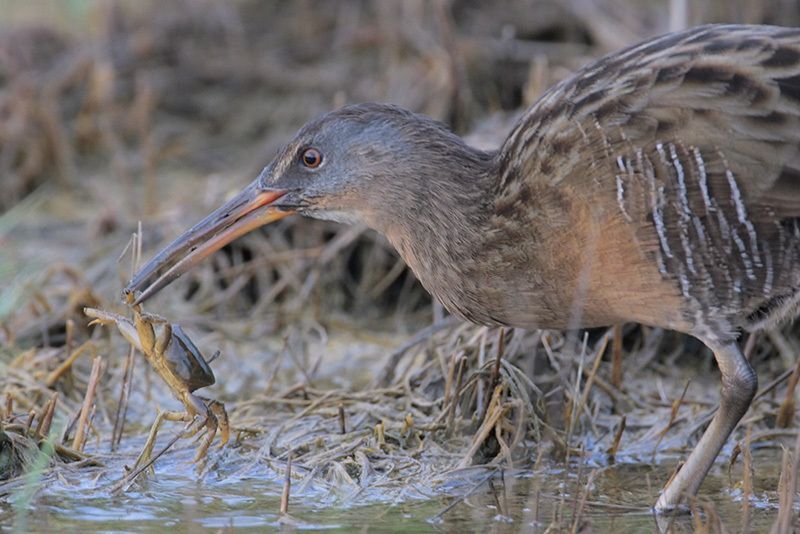Clapper Rail

© Alan Murphy
Rallus crepitans
Family: (Rallidae) Rails, Gallinules, and Coots
Preferred Habitat: Salt marshes.
Seasonal Occurrence: Resident; uncommon all seasons.
Profile by Azure Bevington: Clapper Rails are secretive birds found mainly in dense vegetation in coastal saltmarshes and mangroves swamps in eastern North America, Central America, and the Caribbean. In 2014, Maley et al. showed that Clappers were taxonomically distinct from the Ridgway's Rail (Rallus obsoletus), found in the Baja region of the U.S. and Mexico, and the Mangrove Rail (Rallus longirostris) of South America. Another cool finding of this work was that a relatively stable hybrid zone is maintained with the freshwater-loving King Rail. This means intermediate hybrids (Cling or Klapping?) can be found regularly, but that distinct populations are maintained by the very strong selection pressure of the ability to process saltwater; Clappers can, Kings can't, while intermediates can only persist in the brackish areas.
Clapper Rails tend to be gray to reddish with dull stripes on the flanks and reddish underside and chest, however there is much regional variation in plumage. They have a slightly down curved bill that is orange toward the base. While they are abundant in coastal wetlands, Clapper Rails are more often heard than seen. Their distinctive repeating chk chk chk call, which resembles the sound of clapping hands, gives away their presence.
Clapper Rails are omnivorous, eating anything they come across, including fiddler crabs, snails, small fish, eggs, and plant matter. They forage and build nests among dense vegetation mainly walking and swimming, they rarely take to the air. Their nests are typically built up on a platform of vegetation to avoid tidal flooding, and often have ramps to enable entry and exit in areas with large water level fluctuations. Eggs that have been submerged in up to 18 inches of water during high tide are still capable of hatching. Young Clapper Rail chicks are downy black when they hatch and can sometimes be seen riding the adults’ backs during periods of high water or when the birds move across open water.
The clap of the Clapper Rail can often be heard calling out in the marsh and salt flats of Houston Audubon’s Bolivar Flats Shorebird Sanctuary. Come down for a walk on the beach and see if you can hear this elusive bird!
Profile by Grace Yaros: Clapper Rails can often be difficult to spot as they forage among dense saltmarsh grasses, and catching a glimpse of these handsome rails is certainly a treat! They are named for their calls: a series of loud, repeated “kek” calls. They are rusty brown overall with gray faces and black-and-white striped sides; note their large size and long, orange bills to distinguish them from Soras, which may be found in saltmarshes on the Upper Texas Coast during winter and migration. They are very similar in appearance to the closely related King Rail, which are found in freshwater and brackish marshes, not saltmarshes.
Clapper Rails can be found in coastal saltmarshes and mangrove swamps along the Atlantic and Gulf Coasts, as well as the Caribbean and Yucatan Peninsula. Populations that breed in southern New England and the Mid-Atlantic migrate to the southern Atlantic Coast for the winter, but other populations are nonmigratory. They are omnivorous, feeding on a variety of fish, crustaceans, and vegetation.
Currently, their populations appear to be stable, though habitat degradation and contamination of coastal wetlands by pesticides and other toxic materials are both threats to Clapper Rail populations. They can be found at Bolivar Flats Shorebird Sanctuary, where you can listen for their calls and may spot one running among the grasses!
-
Cornell Lab of Ornithology
-
Bird Guide

© Greg Lavaty, www.texastargetbirds.com

© Greg Lavaty, www.texastargetbirds.com

© Greg Lavaty, www.texastargetbirds.com




















